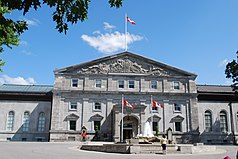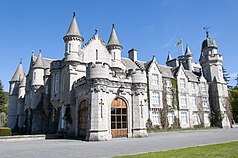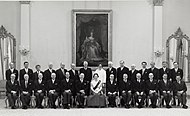The Crown

The Crownbroadly represents thestatein all its aspects within thejurisprudenceof theCommonwealth realmsand their subdivisions (such as theCrown Dependencies,overseas territories,provinces,orstates).[1]The term can be used to refer to the office of the monarch or the monarchy as institutions; to therule of law;or to the functions ofexecutive(the Crown-in-council),legislative(the Crown-in-parliament), andjudicial(the Crown on the bench) governance and thecivil service.[2]
The concept of the Crown as acorporation soledeveloped first in theKingdom of Englandas a separation of the physical crown and property of the kingdom from the person and personal property of the monarch. It spread through English and laterBritish colonisationand is now rooted in the legal lexicon of all 15 Commonwealth realms, their various dependencies, and states infree associationwith them. It is not to be confused with any physicalcrown,such as those of theBritish regalia.[3]
The term is also found in various expressions such asCrown land,which some countries refer to aspublic landorstate land;as well as in some offices, such asminister of the Crown,Crown attorney,andCrown prosecutor.
Definition[edit]
The termthe Crowndoes not have a single definition. Legal scholars Maurice Sunkin and Sebastian Payne opined, "the nature of the Crown has been taken for granted, in part because it is fundamental and, in part, because many academics have no idea what the termthe Crownamounts to ".[4]Nicholas Browne-Wilkinsontheorised that the Crown is "an amorphous, abstract concept" and, thus, "impossible to define",[5]whileWilliam Wadestated the Crown "means simply the Queen".[6]
Warren J. Newman described the Crown is "a useful and convenient means of conveying, in a word, the compendious formal, executive and administrative powers and apparatus attendant upon the modern constitutional and monarchical state."[7]
The Lord Simon of Glaisdalestated, "the crown is a piece of bejewelled headgear under guard at theTower of London;but, one that symbolises the powers of government, which were formerly wielded by the wearer of the crown ".[5]
The Lord Diplocksuggested the Crown means "the government [and] all of the ministers and parliamentary secretaries under whose direction the administrative work of the government is carried out by the civil servants employed in the various government departments."[5]This interpretation was supported by section 8 of thePensions (Colonial Service) Act 1887(50 & 51 Vict.c. 13), which set the terms "permanent civil service of the state", "permanent civil service of Her Majesty" and "permanent civil service of the Crown" as having the same meaning.[8]
Concept[edit]
The concept ofthe Crowntook form under thefeudal system.[9]Though not used this way in all countries that had this system, in England, all rights and privileges were ultimately bestowed by the ruler. Land, for instance, was granted by the Crown to lords in exchange for feudal services and they, in turn, granted the land to lesser lords. One exception to this was commonsocage:owners of land held as socage held it subject only to the crown. When such lands become ownerless, they are said toescheat;i.e. return to direct ownership of the Crown (Crown land).Bona vacantiais theroyal prerogativeby which unowned property, primarily unclaimed inheritances, becomes the property of the Crown.[n 1][10]
As such, the physical crown and the property belonging to successive monarchs in perpetuity came to be separated from the person of the monarch and his or her private property. After several centuries of the monarch personally exercising supreme legislative, executive, and judicial power, these functions decreased as parliaments, ministries, and courts grew through the 13th century.[11]The termthe Crownthen developed into a means by which to differentiate the monarch's official functions from his personal choices and actions.[12]Even within mediaeval England, there was thedoctrine of capacitiesseparating the person of the king from his actions in the capacity of monarch.[13]
When thekingdom of Englandmerged with those ofScotlandand Ireland,the concept extended into the legal lexicons of the United Kingdom and its dependencies and overseas territories and, eventually, all of the independentCommonwealth realms.There are, thus, now many distinct crowns, as a legal concept, "worn by" —or many different offices of monarch occupied by—one person assovereign(supreme monarch) of each country.[14]However,the Crowncan also mean the pan-national institution shared by all 15 Commonwealth realms.[12]
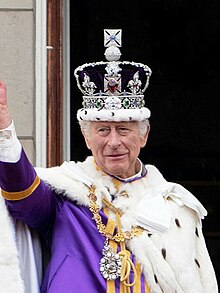
In each Commonwealth realm, the termthe Crown,at its broadest, now means thegovernmentor the polity known asthe state,while the sovereign in all realms is the livingembodimentof the state,[15]or symbolicpersonificationof the Crown.[n 2][29]The body of the reigning sovereign thus holds two distinct personas in constant coexistence, an ancient theory of the "King's two bodies" —the body natural (subject to infirmity and death) and the body politic (which never dies).[14]The Crown and the sovereign are "conceptually divisible but legally indivisible [...] The office cannot exist without the office-holder".[n 3][31]
The termsthe state,the Crown,[32]the Crown in Right of [jurisdiction],His Majesty the King in Right of [jurisdiction],[33]and similar, are all synonymous and the monarch'slegal personalityis sometimes referred to simply as the relevant jurisdiction's name.[22][34](In countries using systems of government derived from Romancivil law,the state is the equivalent concept.[35]) However, the termsthe sovereignormonarchandthe Crown,though related, have different meanings:The Crownincludes both the monarch and the government. The institution and powers of the Crown are formally vested in the king, but,conventionally,its functions are exercised in the sovereign's name byministers of the Crown[n 4]drawn from andresponsible tothe elected chamber ofparliament.[36]
Still, the king or queen is the employer of all government officials and staff (including theviceroys,judges, members of the armed forces, police officers, and parliamentarians),[n 5]the guardian of foster children (Crown wards), as well as the owner of all state lands (Crown land), buildings and equipment (Crown property),[38]state-owned companies (Crown corporations orCrown entities),[39]and the copyright for government publications (Crown copyright).[40]This is all in his or her position as sovereign, not as an individual; all such property is held by the Crown in perpetuity and cannot be sold by the sovereign without the properadvice and consentof his or her relevant ministers.
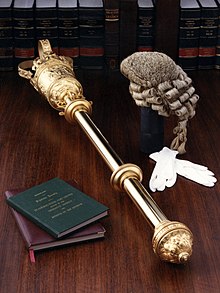
The Crown also represents the legal embodiment of executive,legislative,andjudicialgovernance. While the Crown's legal personality is usually regarded as acorporation sole,[41]it can, at least for some purposes, be described as acorporation aggregateheaded by the monarch.[42][43]Frederic William Maitlandargued the Crown is a corporation aggregate embracing the government and the "whole political community".[44]J.G. Allen preferred to view the Crown as a corporation sole; one office occupied by a single person, enduring "through generations of incumbents and, historically, lends coherence to a network of other institutions of a similar nature."[45]Canadian academic Philippe Lagassé found the crown "acts in various capacities, as such: crown-in-council (executive); crown-in-parliament (legislative); crown-in-court (judicial). It is also an artificial person and office as a corporation sole. At its most basic," the Crown "is, in the UK and other Commonwealth realms, what in most other countries is" the state "."[46]
Divisibility of the Crown[edit]
Historically, the Crown was considered to be indivisible.[47]Two judgments—Ex parte Indian Association of Alberta(EWCA,1982) andEx parte Quark(House of Lords,2005)—challenged that view. Today, it is considered separate in every country, province, state, or territory, regardless of its degree of independence, that has the shared monarch as part of the respective country's government; though, limitations on the power of the monarchin right ofeach territory vary according to relevant laws, thus making the difference between full sovereignty, semi-sovereignty, dependency, etc. The Lords of Appeal wrote, "the Queen is as much the Queen of New South Wales and Mauritius and other territories acknowledging her as head of state as she is of England and Wales, Scotland, Northern Ireland, or the United Kingdom."[48]
The Crown in each of the Commonwealth realms is a similar, but separate, legal concept. To distinguish the institution's role in one jurisdiction from its place in another, Commonwealth law employs the expressionthe Crownin Rightof [place];for example, the Crown in Right of the United Kingdom,[53]the Crown in Right of Canada, the Crown in Right of the Commonwealth of Australia, etc. Because both Canada and Australia are federations, there are also crowns in right of eachCanadian province[54]and eachAustralian state.When referring to the Crown in multiple jurisdictions, wording is typically akin to "the Crown in right of [place], and all its other capacities".[55]
The powers of a realm's crown are exercised either by the monarch, personally, or by his or her representative on theadviceof the appropriate localministers,legislature, or judges, none of which may advise the Crown in any other realm.
New Zealand[edit]
In New Zealand, the termthe Crown(Māori:te Karauna[56]) is used to mostly mean the authority of government; its meaning changes in different contexts.[57][58]In the context of people considering theclaims and settlements related to the Treaty of Waitangi,professor of historyAlan Warddefines the Crown as "the people of New Zealand—includingMāorithemselves—acted through elected parliament and government. "[59]
Crown Dependencies[edit]
In theBailiwick of Guernsey,legislation refers tothe Crown in Right of the Bailiwick of Guernsey[60]orthe Crown in Right of the Bailiwick[61]and the law officers of the Crown of Guernsey submitted that, "the Crown in this context ordinarily means the Crown in right of therépubliqueof the Bailiwick of Guernsey "[62]and that this comprises "the collective governmental and civic institutions, established by and under the authority of the monarch, for the governance of these islands, including the states of Guernsey and legislatures in the other islands, the royal court and other courts, the lieutenant governor, parish authorities, and the Crown acting in and through the Privy Council".[63]

In theBailiwick of Jersey,statements by thelaw officers of the Crowndefine the Crown's operation in that jurisdiction asthe Crown in Right of Jersey,[64]with all Crown land in the Bailiwick of Jersey belonging to the Crown in Right of Jersey and not to theCrown Estateof the United Kingdom.[65]The Succession to the Crown (Jersey) Law 2013 defined the Crown, for the purposes of implementing thePerth Agreementin Jersey law, as theCrown in Right of the Bailiwick of Jersey.[66]
Legislation in theIsle of Manalso defines the Crown in Right of the Isle of Man as being separate from the Crown in Right of the United Kingdom.[67]
British Overseas Territories[edit]
Following theLords' decisioninEx parte Quark,2005, it is held that the King, in exercising his authority overBritish Overseas Territories,does not act on the advice of theCabinet of the United Kingdom,but, in his role as king of each territory, with the exception of fulfilling the UK's international responsibilities for its territories. To comply with the court's decision, the territorial governors now act on the advice of each territory's executive and the UK government can no longer disallow legislation passed by territorial legislatures.[68]
In the courts[edit]
This articleneeds additional citations forverification.(December 2021) |
Incriminal proceedings,the state is the prosecuting party; the case is usually designated (incase citation) asR v [defendant],[69]whereRcan stand for eitherrex(if the current monarch is male) orregina(if the monarch is female), and thevstands forversus.For example, a criminal case against Smith might be referred to asR v Smithand verbally read as "the Crown against Smith".

The Crown is, in general,immune to prosecution and civil lawsuits.So,Ris rarely (albeit sometimes[n 6]) seen on the right hand side of the 'v' in the first instance. To pursue a case against alleged unlawful activity by the government, a case injudicial reviewis brought by the Crown against aminister of the Crownon the application of aclaimant.The titles of these cases now follow the pattern ofR (on the application of [X]) v [Y],notated asR ([X]) v [Y],for short. Thus,R (Miller) v Secretary of State for Exiting the European UnionisR (on the application of Miller and other) v Secretary of State for Exiting the European Union,where "Miller" isGina Miller,a citizen. Until the end of the 20th century, such case titles used the patternR v Secretary of State for Exiting the European Union,ex parteMiller.Either form may be abbreviatedR (Miller) v Secretary of State for Exiting the European Union.
InScotland,criminal prosecutions are undertaken by thelord advocate(or the relevantprocurator fiscal) in the name of the Crown. Accordingly, the abbreviationHMAis used in theHigh Court of JusticiaryforHis/Her Majesty's Advocate,in place ofrexorregina;as in,HMA v Al Megrahi and Fahima.
Most jurisdictions inAustraliauseRorThe King(orThe Queen) in criminal cases. If the Crown is the respondent to an appeal, the wordsThe Kingwill be spelled out, instead of using the abbreviationR(i.e. the case name at trial would beR v Smith;if the defendant appeals against the Crown, the case name would beSmith v The King). InWestern AustraliaandTasmania,prosecutions will be brought in the name of the respective state instead of the Crown (e.g.The State of Western Australia v Smith).Victoriantrials in the original jurisdiction will be brought in the name of thedirector of public prosecutions.TheCommonwealth director of public prosecutionsmay choose which name to bring the proceeding in. Judges usually refer to the prosecuting party as simply "the prosecution" in the text of judgments. In civil cases where the Crown is a party, it is a customary to list the body politic (e.g.State of QueenslandorCommonwealth of Australia) or the appropriate government minister as the party, instead. When a case is announced in court, the clerk or bailiff may refer to the Crown orally asour sovereign lord the king(orour sovereign lady the queen).
In reporting on court proceedings inNew Zealand,news reports will refer to the prosecuting lawyer (often called a Crown prosecutor, as in Canada and the United Kingdom) as representing the Crown; usages such as, "for the Crown, Joe Bloggs argued", being common.
The Crown can also be a plaintiff or defendant in civil actions to which the government of the Commonwealth realm in question is a party. Suchcrown proceedingsare often subject to specific rules and limitations, such as the enforcement of judgments against the Crown.Qui tamlawsuits on behalf of the Crown were once common, but have been unusual since theCommon Informers Act 1951ended the practice of allowing such suits by common informers.
Crown forces[edit]
The term "Crown forces" has been used byIrish republicansandnationalists,including members ofparamilitarygroups, to refer to Britishsecurity forceswhich operate inIreland.The term was used by various iterations of theIrish Republican Army(IRA) during conflicts such asIrish War of Independenceandthe Troubles.As noted by Irish republicanDanny Morrison,"[t]he term 'security forces' suggestslegitimacy,which is why republicans prefer terms like 'the Brits' or 'the Crown Forces', which undermines their authority. "[a][71]Due to the Irish War of Independence, "the phrase 'Crown Forces' came to represent something abhorrent in the Republican narrative".[72]
See also[edit]
Notes[edit]
- ^Jurisdictions in which this prerogative does not apply includeCornwall,where unowned property becomes the property of theduke of Cornwall,andLancashire,where it becomes the property of theduke of Lancaster.
- ^In the Canadian context, the monarch has been described byEugene Forseyas the "symbolic embodiment of the people—not a particular group or interest or party, but the people; the whole people";[16]his daughter, Helen Forsey, said of his opinion on the Crown, "for him, the essence of the monarchy was its impartial representation of the common interests of the citizenry as a whole, as opposed to those of any particular government."[16]TheDepartment of Canadian Heritagesaid the Crown serves as the "personal symbol of allegiance, unity, and authority for all Canadians,"[17][18]a concept akin to that expressed byKing Louis XIV:"L'État, c'est moi",or," I am the state ".[19]Robertson Daviesstated in 1994, "the Crown is the consecrated spirit of Canada",[20]and past Ontario chairman of theMonarchist League of CanadaGary Toffoli opined, "the Queen is the legal embodiment of the state at both the national and the provincial levels [...] She is our sovereign and it is the role of the Queen, recognized by the constitutional law of Canada, to embody the state."[21]
- ^As Peter Boyce put it, "the Crown as a concept cannot be disentangled from the person of the monarch, but standard reference to the Crown extends well beyond the Queen's person."[30]
- ^Executiveswho are themselves servants of the Crown.[36]
- ^TheSupreme Courtfound in the 1980 caseAttorney General of Quebec v. Labrecquethatcivil servantsin Canada are not contracted by an abstraction calledthe state,but, rather, they are employed by the monarch, who "enjoys a general capacity to contract in accordance with the rule of ordinary law."[37]
- ^For exceptions in the United Kingdom, seeCrown Proceedings Act 1947.
- ^InDanny Morrison's words, "[t]he term 'security forces' suggestslegitimacy,which is why republicans prefer terms like 'the Brits' or 'the Crown Forces', which undermines their authority. "[70]
References[edit]
- ^Jackson, Michael D. (2013),The Crown and Canadian Federalism,Dundurn,ISBN978-1-4597-0989-8
- ^Carroll, Alex (2003).Constitutional and Administrative Law.Pearson/Longman. p. 7.ISBN978-0-582-47343-0.
- ^CharlotteDunn (4 June 2018)."Crown Dependencies".The Royal Family.Retrieved1 September2021.
- ^Sunkin, Maurice; Payne, Sebastian (1999),The Nature of the Crown: A Legal and Political Analysis,Oxford: Oxford University Press
- ^abcTown Investments v Department for the Environment,Lord Morris of Borth-y-Gest, Lord Simon of Glaisdale, Lord Kilbrandon, Lord Edmund-Davies,359 (House of Lords 1978).
- ^Wade, William, "The Crown, Ministers, and Officials: Legal Status and Liability", in Sunkin, M.; Payne, S. (eds.),The Nature of the Crown,p. 24
- ^Newman, Warren J. (2017), Lagassé, Philippe; MacDonald, Nicholas A. (eds.),"The Crown in the 21st Century"(PDF),Review of Constitutional Studies,Some Observations on the Queen, the Crown, the Constitution, and the Courts,22(1), Edmonton: Centre for Constitutional Studies: 56,retrieved5 June2023
- ^Torrance 2023,pp. 9–10
- ^Maitland, Frederic(1901)."The Crown as Corporation".Law Quarterly Review(17): 131–46.
- ^Nguyen, Nam H. (18 March 2018).Essential 25000 English-Cebuano Law Dictionary.Nam H Nguyen.
- ^Torrance, David (11 January 2023),The Crown and the Constitution(PDF),House of Commons Library, p. 8,retrieved1 March2023
- ^abTorrance 2023,p. 7
- ^Valente, Claire (2003).The Theory and Practice of Revolt in Medieval England.Ashgate: Aldershot. p. 30.ISBN0-7546-0901-4.
- ^abTwomey, Anne (17 September 2020), "Royal Succession, Abdication, and Regency in the Realms", in Hazell, Robert; Morris, Bob (eds.),The Role of Monarchy in Modern Democracy: European Monarchies Compared(PDF),London: Bloomsbury Publishing, p. 34,ISBN978-1-5099-3103-3,retrieved2 May2023
- ^Elizabeth II(2005), "46.1.b",Interpretation Act,Ottawa: Queen's Printer for Canada (published 1 April 2005),retrieved7 August2009
- ^abForsey, Helen (1 October 2010)."As David Johnson Enters Rideau Hall..."The Monitor.Ottawa: Canadian Centre for Policy Alternatives.Retrieved23 January2011.
- ^Department of Canadian Heritage,Ceremonial and Canadian Symbols Promotion > The crown in Canada,Queen's Printer for Canada,retrieved19 February2009
- ^Department of Canadian Heritage(2010),Canada: Symbols of Canada(PDF),Ottawa: Queen's Printer for Canada, p. 3,retrieved4 December2016
- ^Derwyn, Shea(10 April 1996),"Bill 22, Legislative Assembly Oath of Allegiance Act, 1995 > 1720",Committee Transcripts: Standing Committee on the Legislative Assembly,Toronto: Queen's Printer for Ontario, archived fromthe originalon 11 June 2011,retrieved16 May2009
- ^Davies, Robertson(8 August 1996).Hunting Stuart and The Voice of the People.Toronto: Simon & Pierre.ISBN978-0-88924-259-3.
- ^Toffoli, Gary (10 April 1996),"Bill 22, Legislative Assembly Oath of Allegiance Act, 1995 > 1620",Committee Transcripts: Standing Committee on the Legislative Assembly,Toronto: Queen's Printer for Ontario, archived fromthe originalon 11 June 2011,retrieved16 May2009
- ^abTable Research Branch of the House of Commons(March 2008)."Compendium of Procedure"(PDF).Ottawa: Queen's Printer for Canada. p. 1.Archived(PDF)from the original on 25 October 2012.Retrieved14 October2009.
- ^Cabinet Secretary and Clerk of the Executive Council (April 2004),Executive Government Processes and Procedures in Saskatchewan: A Procedures Manual(PDF),Regina: Queen's Printer for Saskatchewan, p. 10,retrieved30 July2009
- ^The Royal Household,The Queen and the Commonwealth > Queen and Canada > The Queen's role in Canada,Queen's Printer,retrieved15 May2009
- ^MacLeod, Kevin S.(2012),A Crown of Maples(PDF)(2 ed.), Ottawa: Queen's Printer for Canada, p. 51,ISBN978-0-662-46012-1,archived fromthe original(PDF)on 4 February 2016,retrieved28 November2012
- ^Marleau, Robert; Montpetit, Camille (2000), "1. Parliamentary Institutions > Institutional Framework > The Crown",House of Commons Procedure and Practice,Ottawa: Queen's Printer for Canada,ISBN2-89461-378-4,archived fromthe originalon 8 October 2012
- ^Citizenship and Immigration Canada(2009),Discover Canada(PDF),Ottawa: Queen's Printer for Canada, p. 2,ISBN978-1-100-12739-2,retrieved3 December2009
- ^Tidridge, Nathan (2011),Canada's Constitutional Monarchy: An Introduction to Our Form of Government,Toronto: Dundurn Press, p. 17,ISBN978-1-4597-0084-0
- ^[22][23][24][25][26][27][28]
- ^Boyce, Peter John (2008a),The Queen's Other Realms: The Crown and Its Legacy in Australia, Canada and New Zealand,Sydney: Federation Press, p. 81,ISBN978-1-86287-700-9
- ^Bowden, James; Philippe, Lagassé (6 December 2012),"Succeeding to the Canadian throne",Ottawa Citizen,archived fromthe originalon 10 January 2013,retrieved6 December2012
- ^Elizabeth II (9 October 2012), "83.1",Financial Administration Act,Queen's Printer for Canada,retrieved6 December2012
- ^Elizabeth II(21 May 2004)."Memorandum for Understanding of Cooperation on Addressing Climate Change"(PDF).Toronto: Queen's Printer for Canada. p. 1.Retrieved16 May2009.
- ^Elizabeth II(2004)."A First Nations–Federal Crown Political Accord"(PDF).1. Ottawa: Assembly of First Nations. p. 3. Archived fromthe original(PDF)on 6 October 2005.Retrieved29 September2009.
- ^Jackson, Michael D. (2013),The Crown and Canadian Federalism,Toronto: Dundurn Press, p. 20,ISBN978-1-4597-0989-8
- ^abTurpin, Colin; Tomkins, Adam (28 June 2007).British Government and the Constitution: Text and Materials.Cambridge University Press. p. 366.ISBN978-1-139-46536-6.Retrieved3 March2024.
- ^Smith, David E. (1995),The Invisible Crown,Toronto: University of Toronto Press, p. 79,ISBN0-8020-7793-5
- ^Department of National Defence."DCBA 414 011759Z Apr 09 MFSI Annual Rates for the Fiscal Year 2009/2010".Queen's Printer for Canada. Archived fromthe originalon 28 August 2009.Retrieved16 May2009.
- ^"Crown Entities Act 2004".New Zealand Legislation.Parliamentary Counsel Office. 25 February 2024.
- ^Canada(PDF)(Map). Queen's Printer for Canada. 2006. Archived fromthe original(PDF)on 26 March 2009.Retrieved16 May2009.
- ^George V (9 April 1925), "s. 180",Law of Property Act 1925,London: King's Printer
- ^Maitland, Frederic(1901),"The Crown as Corporation",Law Quarterly Review(17): 131–46
- ^The Law Commission (November 1996),"Paper 143: The execution of deeds and documents by or on behalf of bodies corporate"(PDF),Halsbury's Laws of England(Affidavit),9(4 ed.), Lincoln County, Nevada (published 1974), 1206
- ^Maitland, Frederic William (1908),The Constitutional History of England,Cambridge: Cambridge University Press, p. 418
- ^Allen, J.G. (July 2018),"The Office of the Crown",Cambridge Law Journal,77(2), Cambridge: 300,doi:10.1017/S0008197318000338,S2CID149843556
- ^Lagassé, Philippe (2 November 2021),The State, The Crown, and Parliament, lecture given at Carleton University,Ottawa
{{citation}}:CS1 maint: location missing publisher (link) - ^Saunders, Cheryl (2015). "The Concept of the Crown".Melbourne University Law Review.38:883.
- ^Lords of Appeal,Ex parte Quark,2005
- ^Lauterpacht, E.; Greenwood, C. J. (1992).International Law Reports.Vol. 87. Cambridge: Cambridge University Press. pp. 286, 713.ISBN978-0-949009-99-9.
- ^Royal Institute of International Affairs (1983).The British Year Book of International Law.Vol. 53. British Institute of International Affairs. Oxford:H. Frowde.pp. 253, 257, 258.
- ^Bourne, C.B. (1986).Canadian Yearbook of International Law.Vol. 23. Vancouver: UBC Press.ISBN978-0-7748-0259-8.
- ^The Australian law journal.Vol. 52. North Ryde: Law Book Co. of Australasia Ltd. 1978. pp. 58, 203, 207. 3910867.
- ^[49][50][51][52]
- ^Ministry of Natural Resources (24 January 2006),Disposition of Public Land to Other Governments and Agencies(PDF),Toronto: Queen's Printer for Ontario, p. 2, at 3.2.B,retrieved25 April2010,
When public land is required by the federal government or one of its departments, or any provincial ministry, the land itself is not transferred. What is transferred is the responsibility to manage the lands on behalf of Her Majesty the Queen (HMQ). This is accomplished by an Order-in-Council or a Minister's Order that transfers management of land either from HMQ in right of Ontario to HMQ in right of Canada as represented by a department or to HMQ in right of Ontario as represented by another ministry. The Crown does not transfer ownership to itself.
- ^Clayton Utz."Retail Leases Comparative Analysis - The Act Binds the Crown".Clayton Utz.Archived fromthe originalon 14 July 2022.Retrieved14 April2023.
- ^"Karauna".Te Aka Māori Dictionary.Retrieved20 January2023.
- ^Shore, Cris; Kawharu, Margaret (17 June 2014)."The Crown in New Zealand: Anthropological Perspectives on an Imagined Sovereign".Sites: A Journal of Social Anthropology and Cultural Studies.11(1): 17–38.doi:10.11157/sites-vol11iss1id267.ISSN1179-0237.
- ^"Definition of 'the Crown' a difficult matter".New Zealand Law Society | Te Kāhui Ture o Aotearoa. 15 November 2019.Retrieved12 May2021.
- ^Hayward, Janine;Wheen, Nicola R.,eds. (2004).The Waitangi Tribunal–Te Roopu Whakamana i te Tiriti o Waitangi.Wellington, N.Z.: Bridget Williams Books.ISBN1-877242-32-2.OCLC60361482.
- ^"Review of the Roles of the Jersey Crown officers"(PDF).Archived fromthe original(PDF)on 22 November 2011.Retrieved7 November2011.
- ^"The Unregistered Design Rights (Bailiwick of Guernsey) Ordinance, 2005".Archived fromthe originalon 21 July 2011.Retrieved7 November2011.
- ^"Review of the Roles of the Jersey Crown officers"(PDF).Retrieved7 November2011.
- ^"It's a power thing…".Guernsey Press.21 June 2010. Archived fromthe originalon 10 June 2011.Retrieved7 November2011.
- ^"Review of the Roles of the Crown Officers"(PDF).Retrieved7 November2011.
- ^"Written Question to H.M. Attorney General".Archived fromthe originalon 27 September 2011.Retrieved7 November2011.
- ^"Succession to the Crown (Jersey) Law 2013".States of Jersey.Retrieved6 October2021.
- ^"The Air Navigation (Isle of Man) Order 2007 (No. 1115)".Retrieved7 November2011.
- ^Overseas Territories: Seventh Report of Session 2007–08, Vol. 2: Oral and Written Evidence.London, UK: The Stationery Office, 6 July 2008, pp. 49, 296–297
- ^"The Queen v Brenton Harrison Tarrant"(PDF).In the High Court of New Zealand Christchurch Registry.Retrieved22 July2022.
- ^Morrison, Danny (24–26 January 2004)."Saving 'Bobby Sands Street' > Words of Freedom".Irish History.Irlandinitiative Heidelberg.Retrieved25 August2015.
- ^Hawes-Bilger, Cordula (2007).War Zone Language: Linguistic Aspects of the Conflict in Northern Ireland.Francke. p. 148.ISBN978-3-7720-8200-9.;O'Neill, Conor (2004). "Terrorism, insurgency and the military response from South Armagh to Falluja".The RUSI Journal.149(5): 22–25.doi:10.1080/03071840408523120.ISSN0307-1847.S2CID152582870.;Tomaney, John (2000). "End of the Empire State? New Labour and Devolution in the United Kingdom".International Journal of Urban and Regional Research.24(3): 675–688.doi:10.1111/1468-2427.00271.ISSN0309-1317.
- ^Ferriter, Diarmaid (1 November 2012).Ambiguous Republic: Ireland in the 1970s.Profile Books. p. 247.ISBN978-1-84765-856-2.Retrieved21 August2015.
Because of the events of the War of Independence, the phrase 'Crown Forces' came to represent something abhorrent in the Republican narrative.
Further reading[edit]
- Sunkin, Maurice; Payne, Sebastian, eds. (1999).The Nature of the Crown: A Legal and Political Analysis.Oxford University Press.doi:10.1093/acprof:oso/9780198262732.001.0001.ISBN978-0-19-826273-2.

